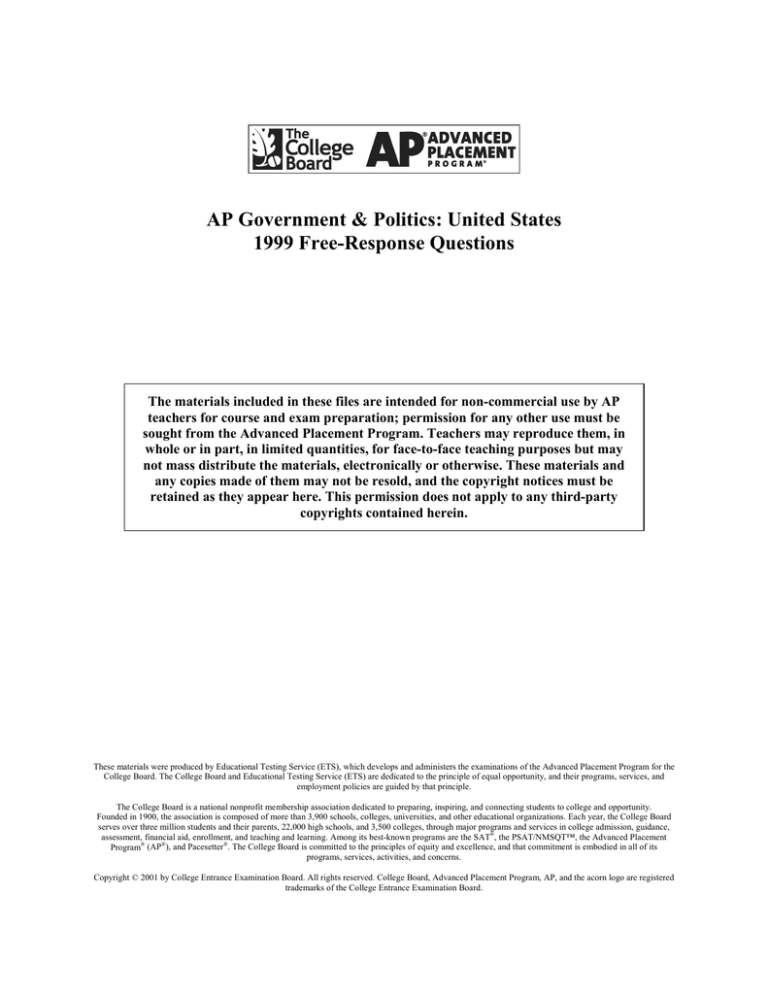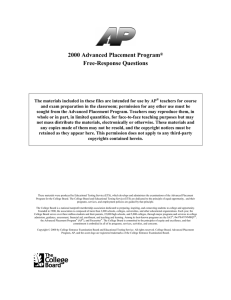AP Government 1999 Free-Response Questions
advertisement

AP Government & Politics: United States 1999 Free-Response Questions The materials included in these files are intended for non-commercial use by AP teachers for course and exam preparation; permission for any other use must be sought from the Advanced Placement Program. Teachers may reproduce them, in whole or in part, in limited quantities, for face-to-face teaching purposes but may not mass distribute the materials, electronically or otherwise. These materials and any copies made of them may not be resold, and the copyright notices must be retained as they appear here. This permission does not apply to any third-party copyrights contained herein. These materials were produced by Educational Testing Service (ETS), which develops and administers the examinations of the Advanced Placement Program for the College Board. The College Board and Educational Testing Service (ETS) are dedicated to the principle of equal opportunity, and their programs, services, and employment policies are guided by that principle. The College Board is a national nonprofit membership association dedicated to preparing, inspiring, and connecting students to college and opportunity. Founded in 1900, the association is composed of more than 3,900 schools, colleges, universities, and other educational organizations. Each year, the College Board serves over three million students and their parents, 22,000 high schools, and 3,500 colleges, through major programs and services in college admission, guidance, assessment, financial aid, enrollment, and teaching and learning. Among its best-known programs are the SAT®, the PSAT/NMSQT™, the Advanced Placement Program® (AP®), and Pacesetter®. The College Board is committed to the principles of equity and excellence, and that commitment is embodied in all of its programs, services, activities, and concerns. Copyright © 2001 by College Entrance Examination Board. All rights reserved. College Board, Advanced Placement Program, AP, and the acorn logo are registered trademarks of the College Entrance Examination Board. 1999 The College Board Advanced Placement Examination GOVERNMENT & POLITICS: UNITED STATES Question 1 In the 1990’s presidential election campaigns have become more candidate centered and less focused on issues and party labels. This change has been attributed both to how the media cover presidential campaigns and to how candidates use the media. Identify and explain two ways in which the media have contributed to candidate-centered presidential campaigns. Identify and explain two ways in which presidential candidates’ use of the media has contributed to candidate-centered campaigns. Your answer should NOT include a discussion of presidential primary elections. Question 2 National interest groups often target national-level policymaking institutions to achieve their policy objectives. Select one of the following national interest groups. • American Association of Retired Persons (AARP) • American Medical Association (AMA) • National Association for the Advancement of Colored People (NAACP) • National Association of Manufacturers (NAM) For the group you selected do each of the following. a. Identify one major national-level policymaking institution that this group targets. b. Describe one resource or characteristic of the group you have chosen AND explain how it influences the choice of the target you have identified in (a). c. Describe another resource or characteristic of the group you have chosen AND explain how it influences the choice of the target you have identified in (a). Copyright © 1999 College Entrance Examination Board and Educational Testing Service. All rights reserved. 1 Question 3 Is Congress effective in exercising legislative oversight of the federal bureaucracy? Support your answer by doing ONE of the following. • Explain two specific methods Congress uses to exercise effective oversight of the federal bureaucracy. OR • Give two specific explanations for the failure of Congress to exercise effective oversight of the federal bureaucracy. Question 4 Using the information in the pie charts above, identify two budgetary barriers that hinder the creation of new policy initiatives. Explain why each of the barriers you identified persists. Using your knowledge of United States politics, identify one nonbudgetary barrier AND explain how this barrier hinders the creation of new policy initiatives. Copyright © 1999 College Entrance Examination Board and Educational Testing Service. All rights reserved. 2


